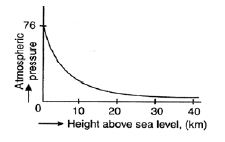This earth is surrounded by air. Atmosphere has weight. So it has pressure. This very pressure on earth surface is almost 105 N per square meter. The atmospheric pressure is 1.5 x 105 N on the body of an adult if the area of his body is 1.5 m2.
As the internal blood pressure of a human body is greater to some extent than the atmospheric pressure, generally it is not felt by the people. The atmosphere for its weight applies force on the earth’s surface and the amount of force acting perpendicularly on per-unit surface area of the earth, is called atmospheric pressure.

The atmospheric pressure depends on the density and height of the atmosphere. On the earth’s surface and on sea level the normal air pressure is 76cm of mercury pressure. With the increase of altitude from the sea-level the weight and density of air-column decreases. So, the air pressure reduces with the increase of height. The atmospheric pressure on the peak of Mount Everest is about 30% of the sea-level air pressure. For this reason respiration becomes difficult at such a high level.
There is a possibility of bleeding from the nose at high altitude as atmospheric pressure is considerably low there. Nowadays normal pressure is kept inside a plane for the convenience of the passengers when it flies at a very high altitude and low pressure region. With the increase of height from the earth’s surface the pressure of the atmosphere decreases. The change of pressure of the atmosphere with altitude is shown in the graph.












